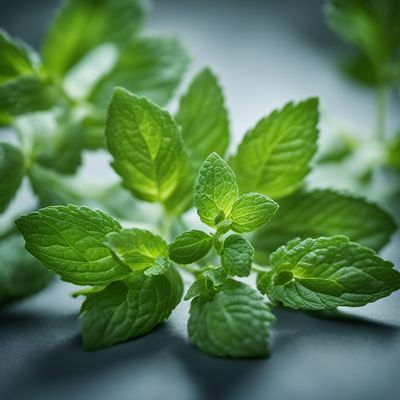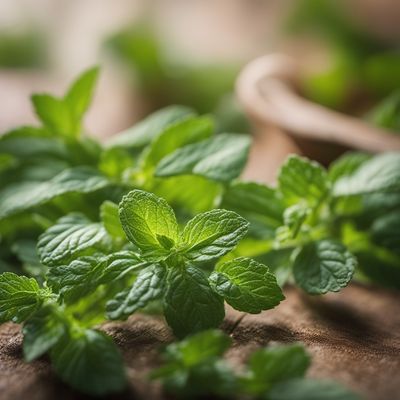
Ingredient
Water mint
"Refreshing Twist: Exploring the Delights of Water Mint"
With its vibrant green leaves and delicate purple flowers, water mint (Mentha aquatica) is a perennial herb that thrives in moist environments. It boasts a distinct aroma and flavor, combining hints of mint, citrus, and earthiness. The leaves are smooth and slightly hairy, while the stems are square-shaped. Water mint's refreshing taste and cooling properties make it a popular choice for teas, cocktails, salads, and desserts. Its texture is tender and succulent, providing a pleasant crunch when added to dishes.
Origins and history
Water mint is native to Europe, Asia, and North America, where it grows abundantly in wetlands, marshes, and along the banks of streams and rivers. It has a rich historical background, with references to its use dating back to ancient times. The ancient Egyptians, Greeks, and Romans valued water mint for its medicinal properties and used it to treat various ailments, including digestive issues and headaches. Over the centuries, water mint has been cultivated and incorporated into traditional cuisines and herbal remedies around the world.
Nutritional information
Water mint is low in calories and a good source of vitamins A and C. It also contains essential minerals such as calcium, iron, and potassium.
Allergens
Water mint may cause allergic reactions in individuals who are sensitive to mint or other members of the Lamiaceae family.
How to select
When selecting water mint, look for vibrant green leaves without any signs of wilting or discoloration. The leaves should have a strong aroma, indicating freshness. Avoid any leaves that appear yellowed or have brown spots.
Storage recommendations
To maintain the freshness of water mint, store it in a plastic bag or container lined with a damp paper towel in the refrigerator. It can stay fresh for up to a week when stored this way.
How to produce
Water mint can be easily grown in a garden or even in containers. It thrives in moist soil and partial shade. Plant water mint in well-draining soil and keep it adequately watered. Regular pruning will help promote healthy growth.
Preparation tips
Water mint can be used in a variety of ways. Add fresh leaves to salads, cocktails, or fruit-infused water for a burst of flavor. It can also be used to make refreshing teas or incorporated into desserts like ice creams and sorbets. When using water mint in cooking, it is best to add it towards the end of the cooking process to preserve its delicate flavor.
Substitutions
If water mint is not available, spearmint or peppermint can be used as suitable substitutes, although they may have slightly different flavor profiles.
Culinary uses
Water mint is commonly used to flavor teas, cocktails, and fruit-infused water. It adds a refreshing touch to salads, dressings, and sauces. It can also be used to enhance the flavor of desserts such as ice creams, sorbets, and fruit salads.
Availability
Water mint is commonly available in Europe, Asia, and North America. It can also be cultivated in home gardens or purchased from specialty herb stores.
More ingredients from this category

Other species and hybrids of genus Mentha, not elsewhere mentioned
The Aromatic Herb Family

Gingermint
The Perfect Blend of Zesty Ginger and Refreshing Mint

Bergamot mint
The Citrus Twist

Pennyroyal
The Versatile Herb: Pennyroyal

Spearmint
"The Refreshing Herb: Unveiling the Delights of Spearmint"

Apple mint
Refreshing Minty Twist

Peppermint
The Refreshing Herb: Peppermint

Corsican mint
"The Refreshing Delight: Discover the Aromatic Magic of Corsican Mint"
Recipes using Water mint » Browse all

Montserrat Mango Salad
Tropical Delight Mango Salad

Malvani Spiced Green Papaya Salad
Tropical Delight: Malvani Spiced Green Papaya Salad

Chruok Svay - Cambodian Spicy Pork Salad
Fiery Delight: A Spicy Twist on Cambodian Pork Salad

Spicy Glass Noodle Salad with Middle Eastern Flavors
Fiery Vermicelli Salad with a Jordanian Twist

Bánh mì đặc biệt - Vietnamese Special Sandwich
Vietnamese Fusion Delight: Bánh mì đặc biệt

Lao-inspired Mixed Vegetable Rice Rolls
Harmony in a Roll: Lao-inspired Mixed Vegetable Rice Rolls

Bún Bò Nam Bộ - Vietnamese Lemongrass Beef Noodle Salad
Zesty Lemongrass Beef Salad: A Burst of Vietnamese Flavors

Fattoush Salad
Levantine Delight: Refreshing Fattoush Salad

Chechen Tomato Salad
Zesty Tomato Delight: A Chechen Twist on a Classic Salad

Fresh and Flavorful Vietnamese Spring Rolls
Delightful Vietnamese Spring Rolls: A Burst of Freshness and Flavor

Refreshing Jellyfish Salad
Ocean Delight: A Vibrant Jellyfish Salad

Indo-style Gyros
Spiced and Flavorful Indo Gyros: A Fusion Delight